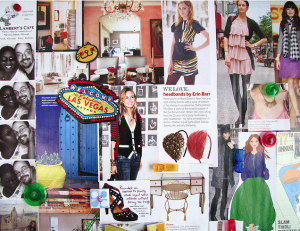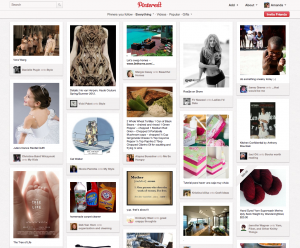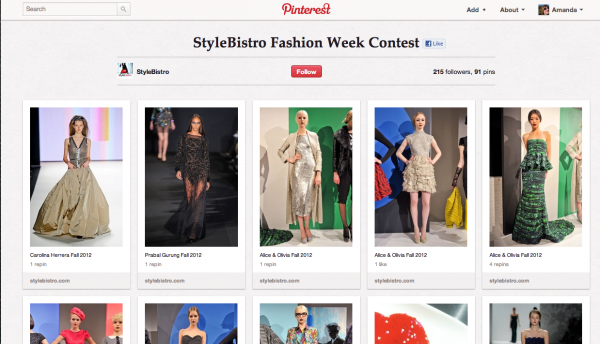Find your brand evangelists and let their creative interests build website traffic
Artists, photographers and other creative-types often employ a space on their wall with something called an “inspiration board”. It’s generally a collection of clippings from magazines, print-outs of things they’ve found online, photographs and keepsakes that inspire their creativity.
Pinterest is today’s most rapidly growing, visually-stimulating social network and it’s built on the concept of these inspiration boards. In fact, if you had to take an inspiration board and create a digital representation, it probably wouldn’t get any better looking than the way that Pinterest is designed.
At its roots, Pinterest is a bookmarking site like Digg or Reddit. When a user visits a website and likes an idea (a recipe, craft project, book, product, etc.) they’re able to “pin” that idea on a board they’ve created on Pinterest. The image acts as the headline, although users are able to add captions, and the image almost always links to the original article. The only time it wouldn’t is if the user uploaded an image themselves. Pinterest doesn’t currently allow users to add links to the images they upload.
[text_ad]
And this is why you care…
Pinterest just clocked in at 11.7 million unique monthly visitors last month. Like other social networks, every user on Pinterest has a group of friends or followers. In their main feed, they can see what their friends are pinning. They can then “like” or “re-pin”, and the functionality works exactly like a “like” would on Facebook and a “retweet” would work on Twitter. The more likes and repins, the greater visibility your post will get. It’s also likely to be featured on the public Pinterest boards, much like the “Front Page” of Digg.
And this is how other publishers are handling it…
The nice thing about Pinterest is that despite the likeliness of spammers coming to try and muck it up, it would be fairly hard for them to be very successful. Affiliate marketers have certainly found a niche here, posting links to products with their affiliate codes in the URLs, in fact, that’s exactly how Pinterest monetizes the network.
Remember though, that in order to gain visibility, your friends need to re-pin your posts. So in order to have any influence you’ll need to gain followers, just like you do on Facebook, Twitter, or any other social network.
StyleBistro has an aggressive brand-centric approach which appears to be working well for them. They only have a hundred or so followers to their main brand account, but popular boards like StyleBistro Fashion Week, Editor’s Picks: Hair, and Celeb Engagement Rings all have over 200 followers each. Oh, did we mention that people can subscribe to your boards, too?
How to get started…
- Install the Pin It plugin: If you run a website where users might be inclined to “pin” your articles, you might want to take a look at the Pin It plugin for WordPress. AddThis also has the functionality with a little elbow grease. Adding this button not only makes it easy for people to “pin” your articles, but it also makes sure that a link back to your website is always included. This slims down the popular error where users pin the link to your image instead of your article.
- Look for inbound links: You might not even know that people are already pinning pages on your site. If you want to know which links are leading back to you, just use this formula to find out:
- http://pinterest.com/source/yourwebsite.com/
- Ask editors to get involved: Like most social networks, a strategy almost always works best with a personal profile. If you run a food, art, or craft-based publication it’s likely that your editors are already on Pinterest. If they are, collaborate on a strategy with them for interjecting their favorite projects or articles from your site. Work on a brand-strategy as well.
- Consider using featured photos: Even B2B publications are getting some love. The trouble is that someone can’t “pin” an article without a featured photo. Which means that if they try to pin it, Pinterest will try to use unrelated photos on your homepage like your logo, someone else’s logo or even an ad image. Not exactly what you want showing up.






Awesome, thanks so much for the extra insight, Julie!! 🙂
Hi! Thank you so much for including StyleBistro in your round up! We really appreciate it! We also are actively commenting on other people’s pins, repining content we feel is on-brand for us and using Pinterest to see what is new, cutting edge and chic. We also love the opportunity to spend hours pinning pretty pictures!
Thanks for the great answer.
I agree that most people would welcome business from exposure. I know I would.
My business partner expressed the worries and now I have some information so we can move forward!
The user absorbs the copyright legalities in these cases. As a user, you agree that you either own the content or have permission to use it. See: http://pinterest.com/about/copyright/ (other very popular bookmarking sites have these same terms).
However, Pinterest now offers any site to install a piece of code that when someone tries to “pin it”, they get a message that says “this website does not allow pinning”. So any website that would not appreciate it (why wouldn’t they want inbound links?) is responsible for installing this code. Honestly, the functionality of Pinterest almost always links back to the original article. I think the problem is when users screenshot images from the web and upload manually without linking back to the original article or artist. Etsy artists also are getting upset because people are pinning their projects on “DIY” boards.
In general, exposure is generally appreciated. Once a business is educated on Pinterest they’re less likely to be upset that someone sent them a wildly popular inbound link to their website and probably generated them revenue. It’s the same as posting a link from Facebook or Twitter, except a photo is used.
What about pinning and copyright – I am not sure I understand where I would be overstepping and where it is allowable. I would hate for some issue to come up because I am pinning images that inspire under a company profile and the owner of the images does not appreciate this.
Thanks for the catch!
Thanks for this post. I think Pinterest is really doing great. One side benefit of Pinterest is that it kind of forces you to improve your own articles as it looks for images to be pinned.
Between you would want to correct the text “11.7 unique monthly visitors” as mentioned in the article. It’s 11.7 million.